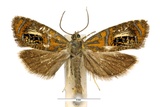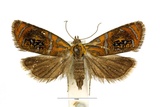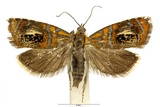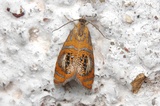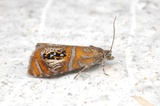Olethreutes arcuella (Clerck, 1759) Species
Last modified: Dec. 4, 2024, 1:34 p.m.
A fairly common species in the northeastern and southern part of Belgium.
Details
- Classification
- Family: Tortricidae > Subfamily: Olethreutinae > Tribus: Olethreutini > Genus: Olethreutes > Species: Olethreutes arcuella
- Vernacular names
- Geisha (NL), Prachtwickler (DE)
- First mention in Belgium
- De Sélys-Longchamps E. 1844. Énumération des insectes Lépidoptères de la Belgique. — Mémoires de la Société royale des Sciences de Liége 2: 1–35. On page 21 (as Carpocapsa arcuana). view page
- Status
-
Native
Distribution
Imago
Wingspan 14–18 mm. Sexual dimorphism not pronounced. Male with a narrow dorsal fold along inner margin and a slight projection at tornus of hindwing.
An unmistakable, striking species. Ground colour of forewing dark brown, overlaid with ferruginous orange except along costa. Radial veins lined with black, most pronounced in discal area. Markings dull plumbeous, edged with black, comprising of three linear streaks in basal area, a transverse, slightly inward-oblique antemedian band, a slightly outward-oblique, curved postmedian streak reaching to tornal area and interrupted medially, and two shorter, oblique pre-apical streaks nearly reaching termen. A large ocellus-like patch of cream colour in the centre bisected by an elongated blotch of black containing three or four plumbeous spots. Cilia grey, with a dark basal line. Hindwing dark grey-brown; cilia paler, with a dark sub-basal line.
Caterpillar
Head yellowish brown, prothoracic plate dark brown, blackish brown or black, abdomen dark purplish grey to violet-brown, pinacula black, anal plate shining brown.
Cocoon/pupa
Pupa reddish brown.
Bionomics
Caterpillars feed in summer and autumn and overwinter under dead leaves on the ground. After hibernation in April and May a pupa is spun op amongst leaf litter on the ground.
The adult moth is diurnal and can often be observed basking in the sunshine on leaves of shrubs or trees. At dark it comes to light.
Flight periods
The adults fly in one generation from early May to the end of July. Also known from a late observation in September.
Observed on
- Substrates:
- Dead leaves
The larva is feeding on withered and decaying leaves of low-growing plants and on fallen leaves of shrubs and trees.
Habitat
The adult moth prefers open but sheltered places such as woodland edges and clearings.
